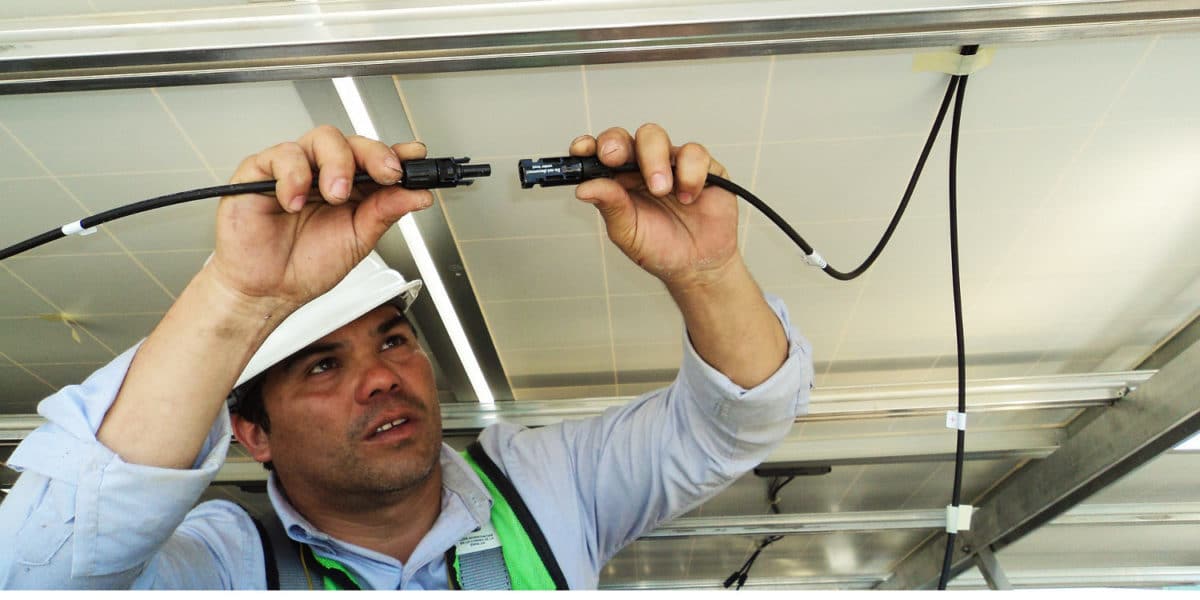Solar connectors represent less than 1% of a typical solar bill of materials (BOM) but poor installation practices spark a problematic number of safety issues and performance concerns.
Why the mismatch? Pressured to lower the levelized cost of energy (LCOE) of projects despite supply chain disruptions, many solar installers, developers, or asset owners feel they must reduce expenses wherever they can. Conflating small size with small importance, developers may think that connectors offer a place to cut corners, and thus save money, without compromising a project’s integrity.
Proper installation is key to product durability
Unfortunately, such penny pinchers are penny wise, pound foolish. Connectors’ small size understate their importance: well-constructed, well-designed solar connectors are essential to project durability. Sloppily-installed connectors may cost solar installations far more over project lifetime than they save upfront, even imperiling the safety of installation or maintenance personnel. Such malfunctions add avoidable hassle and expense.
Developers who truly want to optimize project economics should internalize the three pillars of proper installation. Investing in the right tools, training, and products upfront can save time and money over project lifetime, increasing safety and performance alike.
Pillar #1: Use the right tool for the job
Tool buyers may be tempted to decrease expenses by purchasing fewer, less specialized tools. Resist this temptation. Installers equipped with the right tools can do their job more smoothly, thoroughly, and accurately, reducing the chance of malfunction that might require repair down the line.
Pillar #2: Train employees thoroughly
Developers looking to minimize labor costs may scale back how much they train installers in solar connectors. Common missteps include poor stripping, poor crimping (often exacerbated by installers using the incorrect crimp tool), poor wire management, and either not torquing or over-torquing sealing caps. Developers can equip installers for on-the-job challenges by educating them on how to recognize and overcome such pitfalls.
Pillar #3: Match connector brands
Given the variety of solar connector brand price points, developers looking to maximize returns may go for the least expensive available brand, even if it doesn’t match the brand used for other connecting parts.
But with solar connectors contributing so low a percentage of system costs, the money saved by mismatching brands is not worth the damage (to budgets or to reputation) that safety or performance issues can entail. Until the industry establishes a common interoperability standard, the best way to ensure compliance with National Electrical Code 2020 is to select connectors that match in type and brand to other connectors in the system.
Reduce risk with connector inspections
Developers or asset owners newly alerted to solar connectors’ performance risk may wonder whether their already-installed connectors are poised for malfunction.
Maintenance professionals can gauge solar connector stress levels with infrared scanning or visual assessment. Personnel armed with thermal cameras can check for higher than average temperatures, while visual inspectors should look for mismatched connectors and/or defamation. (Ideally, inspections involve both infrared and visual checks.)
Pennies spent, dollars saved
Given the high labor cost of fixing or replacing malfunctioned equipment in the field, developers that spend just a few more cents on ensuring quality installations can save significantly over project lifetime.
As a best practice, look to work with suppliers that invest in solar component innovations targeted to decrease labor costs and boost ease of use. Researching available options beforehand will save time on installation and maintenance while improving the safety and performance of the solar project.
Presenting just 1% of the BOM, solar connectors are a pivotal component of a successful project well worth the additional upfront pennies to ensure equipment that merits confidence. Savvy developers will skimp elsewhere.
Eric Potter is a field application engineer at Amphenol Industrial. Founded in 1932 and headquartered out of Connecticut, Amphenol is a Fortune 500 company with more than 90,000 employees throughout the world. From the cell phone in your pocket and the car you drive, to the network equipment behind your favorite app and website, Amphenol products are everywhere.
The views and opinions expressed in this article are the author’s own, and do not necessarily reflect those held by pv magazine.
This content is protected by copyright and may not be reused. If you want to cooperate with us and would like to reuse some of our content, please contact: editors@pv-magazine.com.








By submitting this form you agree to pv magazine using your data for the purposes of publishing your comment.
Your personal data will only be disclosed or otherwise transmitted to third parties for the purposes of spam filtering or if this is necessary for technical maintenance of the website. Any other transfer to third parties will not take place unless this is justified on the basis of applicable data protection regulations or if pv magazine is legally obliged to do so.
You may revoke this consent at any time with effect for the future, in which case your personal data will be deleted immediately. Otherwise, your data will be deleted if pv magazine has processed your request or the purpose of data storage is fulfilled.
Further information on data privacy can be found in our Data Protection Policy.